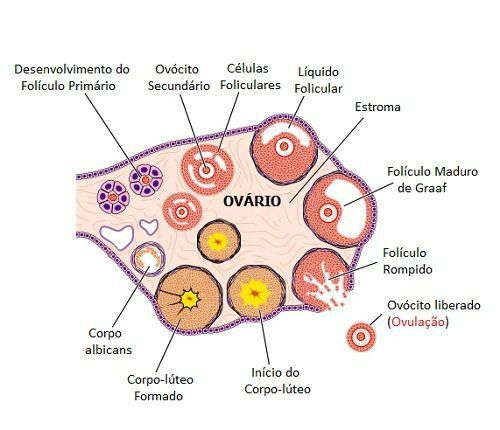Ovulation occurs when there is female gamete release through the ovarian follicles, this happens on the surface of the ovary and it moves to the fallopian tube.
This phenomenon marks the fertile period of the woman, that is, if there is sexual intercourse to woman can get pregnant.
the secondary oocyte
We usually say "egg" to refer to the cell that is released from the fallopian tube, but actually during ovulation and all the time. before fertilization, the egg is in the secondary oocyte stage. This is because meiosis was interrupted in metaphase II and will only be completed if fertilization takes place.
In other words, the egg will only be an egg and will be ready to be fertilized when it finds the sperm. If this does not happen, the oocyte will die about 24 hours after being released and eliminated during menstruation.
Ovarian Follicles and Ovulation
 Ovulation stages.
Ovulation stages.
Ovarian follicles are made up of a set of follicular cells, which contain a primary oocyte inside.
Stimulated by the FSH hormone
the follicles develop, and within them the primary oocyte passes through the first meiotic division, giving rise to the secondary oocyte.Ovulation happens
During the menstrual cycle (whose duration varies between 28 and 30 days from one woman to another) some ovarian follicles are stimulated to develop, however only one will mature and be released.
The follicle accumulates fluid and increases in size (It grows about 2mm a day until it reaches about 25mm) forming a bulge on the surface of the ovary.
The LH hormone acts on the mature follicle, stimulating its rupture and the release of the secondary oocyte, ovulation takes place.
Formation of the corpus luteum
The follicle, which has broken off on the surface of the ovary, forms the corpus luteum or corpus luteum, which is like a scar. The corpus luteum has a yellowish color due to the accumulation of lutein (a carotenoid) that has this color.
Fertile period
It is the period of the menstrual cycle when a woman is more likely to become pregnant if she has sexual intercourse. It corresponds to the period in which ovulation takes place, also considering the survival time of the sperm and egg.
The egg's lifespan is approximately 24 hours after being released from the ovary, while the sperm lasts up to 72 hours inside the woman's body.
 Graph depicting ovulation and changes in hormone levels during the menstrual cycle.
Graph depicting ovulation and changes in hormone levels during the menstrual cycle.
sex hormones
The entire reproductive process totally depends on sex hormones to happen. The maturation of ovarian follicles and secondary oocyte release are related to hormones FSH (follicle-stimulating hormone) and LH (luteinizing hormone), which begin to act during the puberty, marking the beginning of a woman's fertile life.
To learn all about Human Reproduction, read also:
- Male Reproductive Device
- Female Reproductive Device
- Puberty
- Menstruation
- Gametes and Gametogenesis
- How does human fertilization occur?
- contraceptive methods
- Human Embryonic Development
-
Pregnancy
- Teenage pregnancy
-
Pregnancy and Childbirth
- Normal delivery x Cesarean delivery

